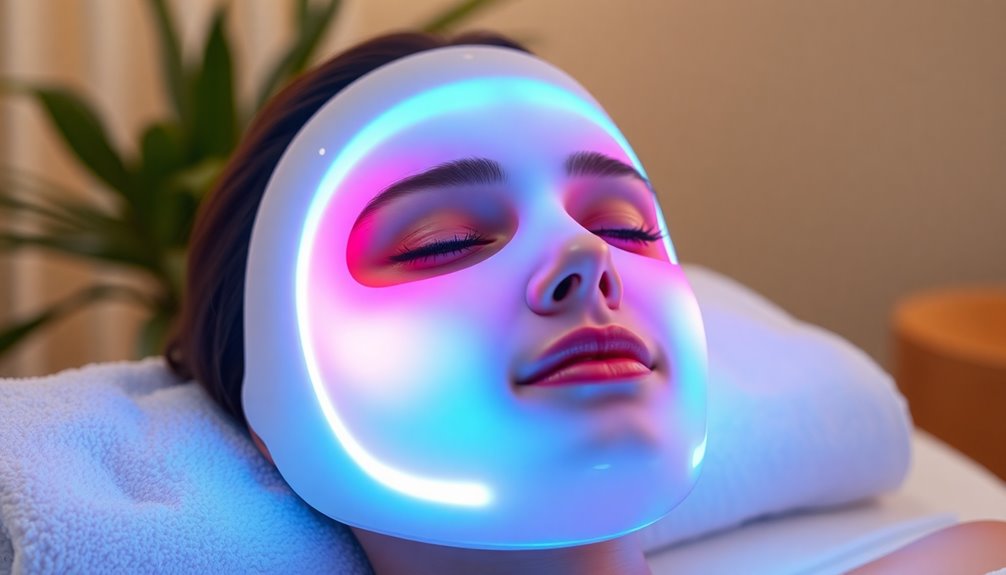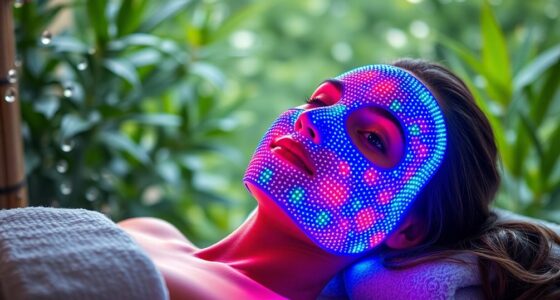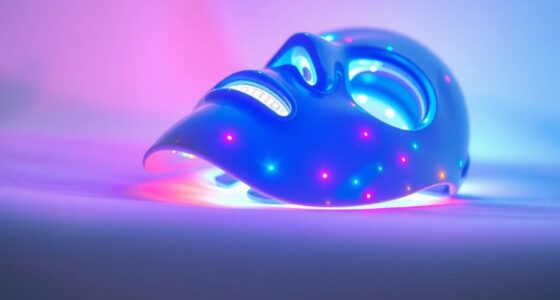LED facial masks use light-emitting diodes to improve your skin’s health by targeting issues like wrinkles, acne, and inflammation. Each mask emits specific wavelengths of light that stimulate collagen production, fight acne bacteria, and promote healing. They provide a non-invasive, at-home therapy, allowing you to easily integrate skin treatments into your busy life. For more insights on their benefits and how to use them effectively, keep exploring this fascinating topic.
Key Takeaways
- LED facial masks use specific light wavelengths to stimulate skin processes, promoting collagen production and reducing wrinkles and fine lines.
- They target acne by regulating oil production and killing acne-causing bacteria with blue light therapy.
- Near-infrared light aids in healing damaged skin and reducing inflammation for a rejuvenated complexion.
- Regular use can improve skin texture, accelerate healing, and decrease scarring, enhancing overall skin health.
- LED masks offer a non-invasive, at-home treatment option that complements professional skincare routines for optimal results.
What Are LED Facial Masks?

LED facial masks are innovative skincare devices that use light-emitting diodes to target specific skin issues like wrinkles and acne.
These LED masks offer an effective skin therapy solution in the comfort of your home. They utilize various wavelengths of light, such as red light, which boosts collagen production, and blue light, which effectively combats acne-causing bacteria.
As a non-invasive option, these at-home devices provide a convenient way to achieve professional-level results without needing salon appointments. Prices vary widely, so you can find a model that fits your budget.
To see significant improvements, consistent use is key—aim for 30-minute sessions several times a week to maximize your results and rejuvenate your skin.
How Do LED Facial Masks Work?

LED facial masks work by using specific wavelengths of light to target different skin concerns.
When you wear the mask, the red light boosts collagen production, while blue light fights acne-causing bacteria.
Understanding how these wavelengths interact with your skin can help you achieve the best results.
Light Wavelengths Explained
When it comes to skincare technology, understanding how light wavelengths work can greatly enhance your experience with facial masks.
LED light therapy uses specific wavelengths to target various skin conditions. For instance, red light LED, ranging from 630 to 660 nanometers, boosts collagen synthesis and offers anti-aging benefits.
On the other hand, blue light therapy, with wavelengths between 405 and 420 nanometers, helps combat acne-causing bacteria. Near-infrared light penetrates deeper, promoting wound healing and reducing chronic inflammation.
Not all LED colors provide the same benefits, so choosing quality masks is essential. Consistent use allows cumulative effects, improving skin texture and reducing signs of aging over time.
Understanding these wavelengths can help you maximize your skincare routine.
Mechanism of Action
The science behind LED facial masks revolves around the specific wavelengths of light they emit, which stimulate various processes in your skin.
Red light, for instance, penetrates deeply into your skin, promoting collagen and elastin production, which reduces fine lines and wrinkles. This wavelength also helps with inflammation, enhancing overall skin healing.
On the other hand, blue light targets acne-causing bacteria by regulating oil production, effectively clearing existing breakouts and preventing future ones.
By utilizing these different wavelengths, LED masks stimulate cellular activity, boost blood circulation, and accelerate the healing of damaged skin.
Benefits of Using LED Facial Masks

Many skincare enthusiasts are discovering the remarkable benefits of using LED facial masks in their routines.
LED face masks really work to reduce wrinkles and stimulate the production of collagen, giving your skin a youthful glow. Regular use can help reduce inflammation and improve skin texture, making them ideal for various skin conditions, including acne.
Studies show that these masks can accelerate healing and reduce scarring, which is a game-changer for your skin care regimen. Plus, they’re FDA approved, ensuring safety for all skin types.
With sessions lasting only 3 to 10 minutes, you can easily multitask while enjoying these benefits, integrating effective skincare into your busy lifestyle.
Types of Light in LED Facial Masks

LED facial masks harness different wavelengths of light to address specific skin concerns, making them versatile tools in your skincare routine. Each type of light serves a distinct purpose:
| Light Color | Wavelengths | Benefits |
|---|---|---|
| Red | 630-660 nm | Stimulates collagen production |
| Blue | 405-420 nm | Targets acne-causing bacteria |
| Near-Infrared | 800-1,400 nm | Promotes healing, reduces inflammation |
Using red light therapy can reduce fine lines and improve skin elasticity. Blue light therapy helps manage breakouts and oil production. Near-infrared light penetrates deeper, promoting overall skin health. By understanding these wavelengths, you can choose the right therapy for your skin’s needs.
Effectiveness of LED Facial Masks

Effectiveness in skincare is often measured by visible results, and LED facial masks can deliver just that. These masks utilize specific wavelengths of light, like red and blue, to target skin concerns.
Clinical studies show that regular use can reduce fine lines and enhance the production of collagen, particularly with red light. While in-office treatments may yield more pronounced effects, at-home LED masks can still offer subtle improvements in skin texture when used consistently.
For best results, it’s crucial to use the masks multiple times a week over several weeks. Keep in mind that the effectiveness can vary based on device quality and individual skin type.
Safety Considerations for LED Facial Masks

Using LED facial masks can be a beneficial addition to your skincare routine, but it’s important to keep safety in mind.
While these masks are generally safe for most users, those with light sensitivity should consult a dermatologist before use. Always wear eye protection during treatments, especially with blue light therapy, to prevent vision issues from spillover light.
Be sure to follow manufacturer instructions regarding recommended usage times, as overuse may cause irritation or redness. Additionally, consider your skin type; individuals with darker skin tones may face a higher risk of discoloration.
While short-term safety has been established, the long-term effects of LED masks are less understood, so approach with caution.
How to Use LED Facial Masks at Home

To get the most out of your LED facial mask at home, start with a clean and dry face.
You’ll need to use the mask according to the manufacturer’s instructions, typically for 3 to 10 minutes per session, to avoid overexposure. For ideal results, aim to use your mask twice a day, five times a week, for at least one month. This consistency can lead to subtle improvements in your skin.
After treatment, apply hydrating skincare products to boost absorption since the light therapy uses can enhance effectiveness. Remember to skip retinoids on the same day to prevent irritation.
Expected Results From LED Facial Masks

While you mightn’t see immediate results, consistent use of LED facial masks can lead to noticeable improvements in your skin over time.
You’ll need to use your light therapy mask regularly—ideally five times a week for about a month—to see dramatic changes.
Red light therapy stimulates proteins that help with collagen production, enhancing skin elasticity and reducing fine lines.
Blue light therapy is used to treat acne by targeting bacteria, which can lead to fewer lesions and quicker wound healing.
Although side effects are minimal, the cumulative benefits include a brighter complexion and diminished acne scars.
Stick with it, and you’ll likely be pleased with the results you achieve!
Comparing At-Home and Professional LED Treatments

When considering LED treatments for your skin, it’s important to understand the differences between at-home devices and professional options.
At-home masks typically have lower power output, which means you’ll need consistent use—often twice daily for 30-60 minutes—to see visible results.
In contrast, professional treatments performed in a dermatologist’s office use advanced, FDA-cleared devices that deliver higher intensities of light, leading to quicker improvements.
If you’re dealing with severe skin issues, board-certified dermatologists often recommend in-office LED therapy, especially for effective acne treatment.
While at-home devices can help maintain your skin, they’re generally less effective than professional treatments, which are backed by extensive clinical research for their efficacy.
Choose wisely based on your specific skin needs.
Frequently Asked Questions
Do LED Face Masks Really Work?
Do LED face masks really work? Yes, they can lead to improvements in skin texture and reduce wrinkles, but results vary from person to person.
While at-home devices mightn’t be as powerful as professional treatments, consistent use—at least five times a week—can yield mild results.
It’s important to follow manufacturer guidelines to guarantee safety and effectiveness.
Keep in mind, though, that long-term studies on many devices are still limited.
How Often Should I Use a LED Face Mask?
You wouldn’t want to binge-watch your favorite show every night, right?
Similarly, you shouldn’t overdo it with your LED face mask. Aim to use it at least five times a week for the best results.
Keep your sessions between 3 to 10 minutes, and make sure to follow the manufacturer’s guidelines to avoid irritation.
After a month of consistent use, you’ll be able to see how it’s working for your skin.
What Are the Disadvantages of a LED Mask?
When considering a LED mask, you should weigh the disadvantages. Overusing it can cause irritation, redness, or inflammation, so following guidelines is essential.
Results may not be as dramatic as professional treatments, requiring consistent use for any visible improvement. Eye safety is also a concern; prolonged exposure can be risky without protective eyewear.
Additionally, the cost can be steep, and mild results mightn’t justify the expense for everyone.
What Are the Benefits of a 7 Color LED Face Mask?
When you use a 7 color LED face mask, you can experience a range of benefits for your skin.
Each color targets specific concerns, like red light boosting collagen and blue light fighting acne.
You’ll notice improved skin tone with green light and reduced redness with yellow.
Regular use can lead to a clearer complexion, enhanced texture, and diminished signs of aging.
Consistency is key; results often appear after several weeks of use.
Conclusion
In a world where glowing skin is just a mask away, LED facial masks offer a convenient way to enhance your skincare routine. By understanding how they work and their benefits, you can make informed choices for your beauty regimen. Remember to follow safety guidelines and be patient—great results take time. So, why not treat yourself to a little self-care? After all, your skin deserves the spotlight!









